Explore the quaint lanes and vibrant cultural tapestry of Weimar, a city that is as much a hub for history enthusiasts as it is for devotees of art, literary and architecture. This city is famous in Germany and for good reason. A lot of things have happened here!
This article is your ultimate guide to the top activities and sights that encapsulate the essence of Weimar, making sure you see the city through the eyes of those who shaped it.
As a lover of stories, I found myself drawn to the rich narrative woven into the very fabric of Weimar. Walking through this city is like perusing the pages of a living history book, with each corner revealing a new chapter—be it the intellectual prowess of the German Enlightenment or the groundbreaking aesthetics of the Bauhaus movement.
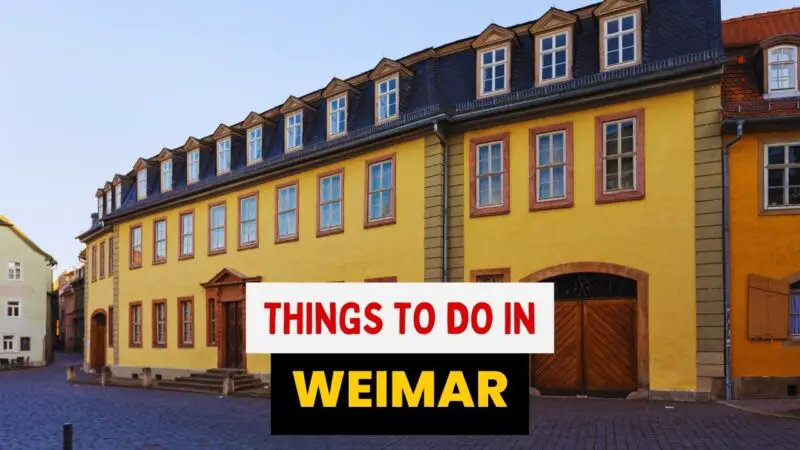
Yet, Weimar is no mere relic of the past; it thrives with cultural life that invites you to engage, reflect, and enjoy.
The experiences here are as diverse as they are profound. There is so much more here than you may realize.
Join me as we uncover the best things to do in Weimar—from strolling through the lush parks and gardens that inspired poets, to standing in the very rooms where political and philosophical thoughts once intersected. This is a city that inspired and motivated so many great minds.
It’s about finding clarity in the simplicity of design at the Bauhaus Museum and unraveling the complex layers of German history with each step. Let’s embark on a journey where the elegance of culture and the gravity of history are accessible to everyone, all within the embrace of this small but mighty city.
Love Germany? Click here to download your free guide to ALL of Germany’s Amazing UNESCO sites. See all 52 of them!
A Brief History of Weimar
The history of Weimar, a city in the federal state of Thuringia in Germany, is rich, reflecting a transformation from a small medieval town to a focal point of European culture and later, political intrigue. Its roots can be traced back to the early 9th century when the settlement was first recorded.
However, it was during the 18th and 19th centuries that Weimar truly flourished as a cultural epicenter.
Weimar’s golden age began under the patronage of Duchess Anna Amalia and continued under her son, Grand Duke Carl August. They fostered an unprecedented cultural environment, inviting luminaries such as Johann Wolfgang von Goethe, Friedrich Schiller, and Franz Liszt to reside and work in the city.
This period, now referred to as the Weimar Classicism, was marked by significant contributions to German literature, philosophy, music, and art, making Weimar synonymous with German enlightenment and humanism.
Moreover, the Bauhaus movement was established in Weimar in 1919 by Walter Gropius. This revolutionary art and design school sought to integrate craftsmanship and the fine arts, and its influence rapidly extended beyond German borders through its minimalist and functional designs.
Although political pressure from the rising National Socialists forced the Bauhaus to move first to Dessau and then to Berlin before its closure in 1933, its ideological roots were firmly planted in Weimar.

Politically, Weimar is known for the National Assembly that convened there after Germany’s defeat in World War I. The assembly was responsible for drafting the Weimar Constitution, which established the Weimar Republic in 1919.
The republic was Germany’s first experiment in democracy, an attempt to steer the nation away from imperial authoritarianism. Regrettably, the Weimar Republic was plagued by economic instability, political extremism, and the Great Depression. These crises eroded public confidence and paved the way for the rise of the Nazi party, leading to its eventual collapse and the establishment of the Third Reich by Adolf Hitler.
In the post-WWII world, Weimar became a part of East Germany, and despite the suppression of intellectual freedom during the GDR era, the city preserved much of its cultural heritage. Following German reunification in 1990, Weimar experienced a renaissance as a cultural destination and was named a UNESCO World Heritage Site for its historical and architectural significance, particularly for sites associated with its classical and Bauhaus legacies.
The complex and contrasting chapters of Weimar’s history, ranging from intellectual and artistic achievements to political anguish, continue to attract scholars and tourists alike, making it a poignant symbol of both the heights and lows of German history.
Top 15 Incredible Things To Do In Weimar
These Weimar attractions are somewhat in geographical order with places to visit in the center area first followed by places further out.
Many of the places to visit in Weimar below are UNESCO listed as part of the Classical Weimar listing. You can read more about this here.
The one thing I found disappointing in Weimar was the lack of English in some of the museums I visited. I was so excited to learn more about this city and all the big things that happened here, but that was hard to do. I didn’t go in every museum in this list so I am not sure if some have more information in English, but if you don’t enjoy museums not in English, you may want to check before you enter any.
What I did love about Weimar was just how GRAND this city seems. It’s easy to walk around and enjoy the architecture and the vibe. It just feels like somewhere where big things happened.
1. Visit the Goethe National Museum (Goethe-Nationalmuseum)
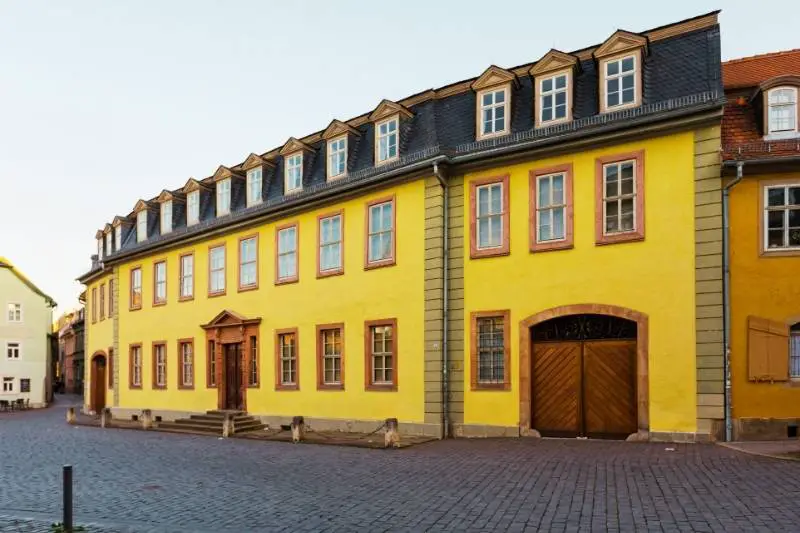
A pilgrimage to the Goethe National Museum is indispensable when visiting Weimar, as it encapsulates the legacy of Germany’s great literary master, Johann Wolfgang von Goethe. Located in Goethe’s former residence, where he lived for almost 50 years, the museum is more than just a window into his life; it’s a complete immersion into his world.
This UNESCO-listed Baroque house, given to Goethe in 1782 to keep him in Weimar, was transformed according to his ideas. It has been left largely as it was, and now showcases not only his living quarters but also an extensive exhibition.
Here, you can wander through various rooms filled with his study materials, scientific instruments, and his extensive art collection, gaining a sense of Goethe’s wide-ranging interests. The adjacent Goethe Archive offers a treasure trove of manuscripts, providing a deeper understanding of his creative process.
The museum lovingly preserves the atmosphere that inspired some of the author’s finest works, offering you an inspiring journey through the German Enlightenment and Romanticism periods led by Goethe himself (and information is in English too!).
2. Take a Tour of the Duchess Anna Amalia Library (Herzogin Anna Amalia Bibliothek)
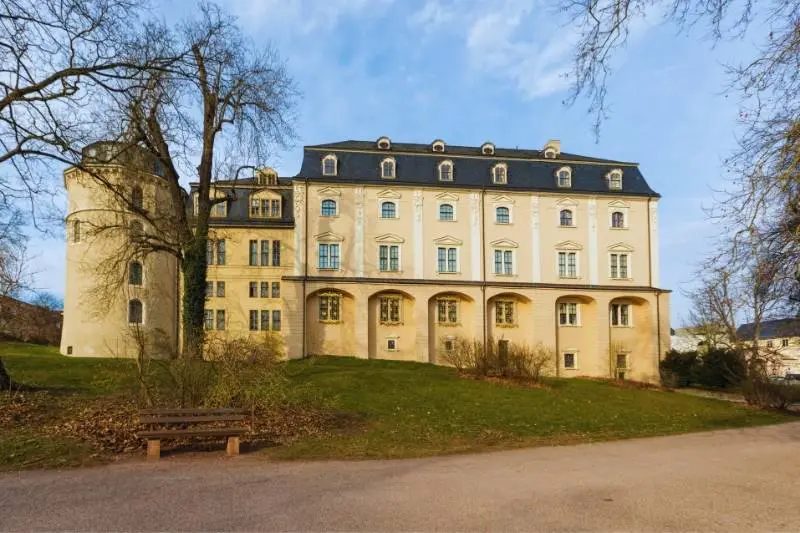
The Duchess Anna Amalia Library warrants its prominent place on this list not just for its impressive collections but also for its sublime architecture and the historical importance it holds in the annals of German literary and intellectual history.
Named after its founder, Duchess Anna Amalia, the library was greatly expanded during her reign in the late 18th century to promote literature and the arts. Its Rococo Hall, restored after a tragic fire in 2004, is particularly breathtaking, with its ornate design and towering shelves filled with leather-bound tomes.
You’ll want to visit here to marvel at the hallways lined with thousands of books dating back hundreds of years, including priceless first editions and manuscripts. The library is also known for its collection of musical scores and literature, and its notable former patrons, like Goethe, Schiller, and Herder, adding to its cultural value.
Exploring this UNESCO World Heritage site is akin to wandering through the enlightened minds of Weimar Classicism.
This place is popular and tickets can and do sell out. It’s recommend to buy them ahead of time especially when visiting in the popular summer months. You can find them on their website.
3. Stroll through Park an der Ilm
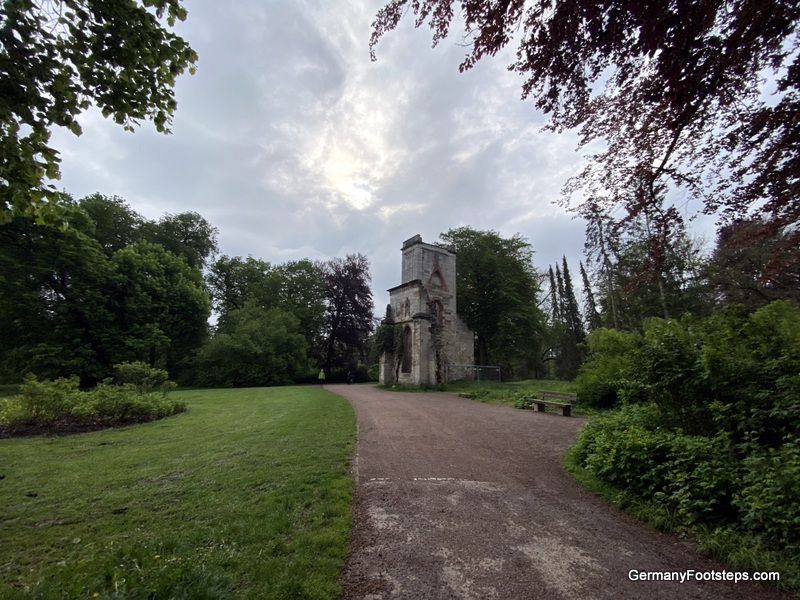
UNESCO-listed Park an der Ilm is the green heart of Weimar, sprawling across 48 hectares along the river Ilm. Historically significant and a masterpiece of landscape design, it was transformed into an English-style park in the 1770s under the guidance of Duke Carl August, with Goethe participating in its design.
Here, you can connect with nature, meander through its many pathways, discover hidden groves, and stumble upon classical temples and sculptures reminiscent of past eras. The Roman House, a neoclassical building within the park, adds an element of architectural beauty and historical significance.
Furthermore, Park an der Ilm provides an inspirational backdrop for Goethe’s Gartenhaus, a rustic retreat where Goethe once worked (coming up next!). Some of the other attractions on this list are also by this park. It’s very cool to walk around, discovering new attractions.
You can also find solace by the gushing river or under the shade of ancient trees, just as Germany’s great writers and philosophers did two centuries ago.
4. Wander through Goethe’s Gartenhaus
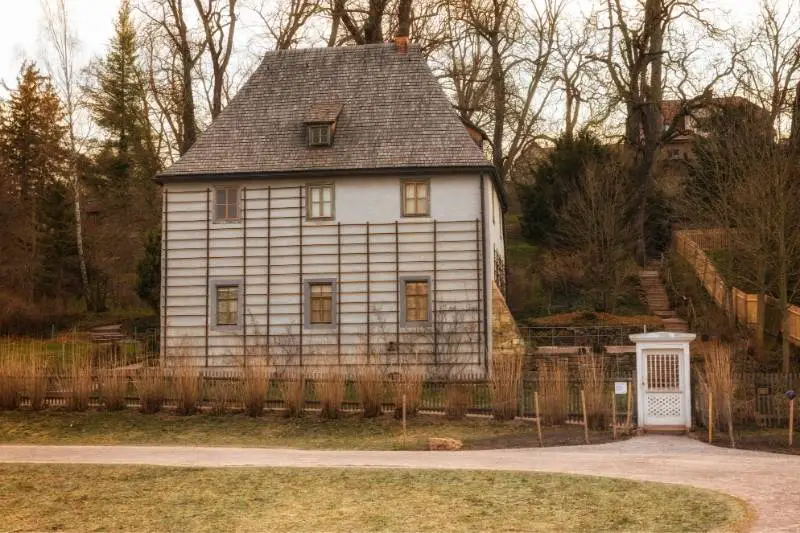
Goethe’s Gartenhaus is not just a quaint garden retreat; it’s an emblem of Goethe’s deep bond with nature which profoundly influenced his writing. After moving to Weimar in 1775, Goethe was also gifted this garden and house by Duke Carl August and it quickly became a haven for his literary creativity.
This simple cottage amidst verdant surroundings offered him solitude and simplicity, contrasting with the complexities of courtly life. Nowadays, you can stroll through the very gardens that inspired Goethe, explore the living and working spaces that remain furnished as in Goethe’s time, and get a personal glimpse into the daily life of this literary titan.
Standing in the modest rooms, with their original wooden panels and the desk where Goethe wrote, is like stepping back into Goethe’s era, making it a palpably authentic historical experience.
5. Unwind at Liszt House (Liszt-Haus)
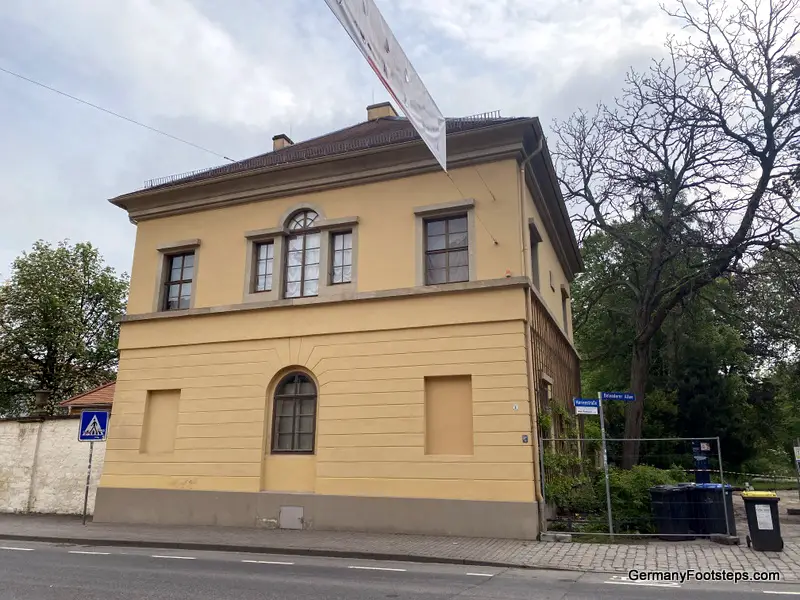
Franz Liszt, the celebrated 19th-century composer, chose Weimar as his home twice, contributing to its reputation as a cultural hub. His residence for his second stint from 1869 to 1886, the Liszt House, is fundamental to understanding Weimar’s musical heritage and is thus a must-visit for music aficionados. Also located at Park an der Ilm, it is easy to visit here.
After his appointment as the Grand Ducal Director of Music Extraordinary in 1842, Liszt transformed Weimar into a center for avant-garde music, attracting numerous students and contemporaries to this modest garden house.
Shortly after his death, it was opened as a memorial and is much as it was while showcasing his life and work, offering a collection of historical instruments, personal items, and music sheets that illustrate Liszt’s impact on classical music.
There’s also the opportunity to listen to his music while you are here.
6. Explore the Museum of Prehistory and Early History of Thuringia (Museum für Ur- und Frühgeschichte
des Archäologischen Landesmuseums Thüringen)
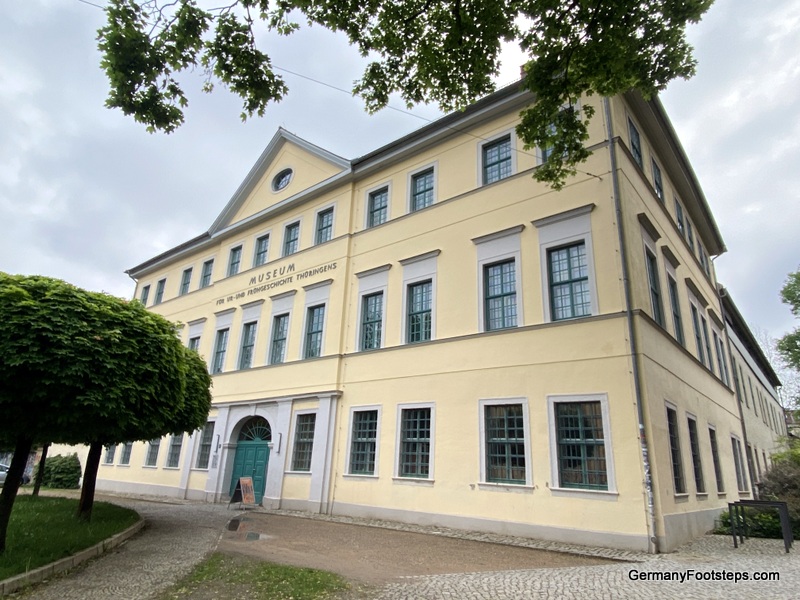
The Museum of Prehistory and Early History of Thuringia offers a profound encounter with the ancient world, allowing you to navigate through the mists of time. Housed in the imposing Weimar Castle, this museum showcases a comprehensive collection that narrates the history of human settlement in Thuringia from the Paleolithic Age right through to the Middle Ages. This is 400,000 years of history!
Each artifact, from delicate stone tools to Bronze Age pottery, tells a story, providing insights into the lives of our distant ancestors. Some of the highlights include the rich troves of the region’s Celtic history and the illustrious Merovingian grave findings that illuminate early medieval society.
I found this museum very interesting – what I was able to translate easily. It’s only in German.
7. Reflect at Fürstengruft
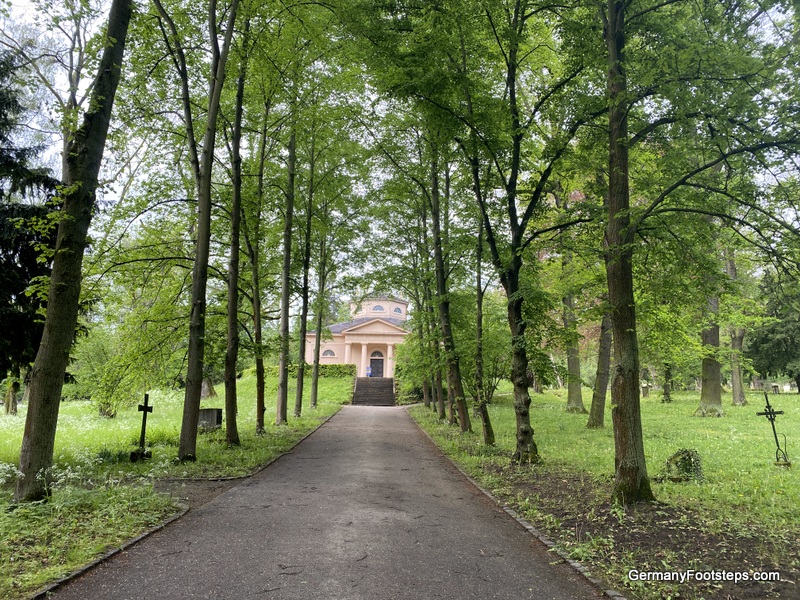
Resting in the peaceful backdrop of the Historical Cemetery, the Fürstengruft, or the Ducal Vault, holds a special significance within Weimar’s cultural panorama. A mausoleum for Weimar’s dukes, the Fürstengruft also astonishingly came to house the remains of the iconic Goethe and what was thought to be Schiller for a time.
This quiet sepulcher, built in the neoclassical style, allows you to reflect on mortality and the enduring legacies individuals can leave behind. The peacefulness of the site offers a stark contrast to the bustling literary life once led by Weimar’s famous residents.
This site continues to be a symbolic hub of reverence and remembrance, honored by literary scholars and admirers alike, making it a place of pilgrimage for those honoring Germany’s rich literary tradition.
8. Explore Schiller’s Residence and Museum (Schillers Wohnhaus and Museum)
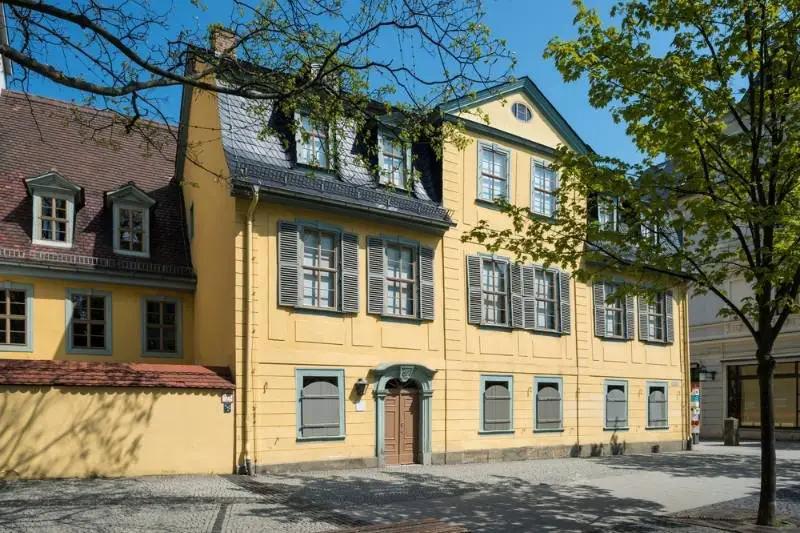
Schiller’s Residence (Wohnhaus), an essential piece of Weimar’s cultural jigsaw, was the home where Friedrich Schiller spent the last three years of his life. This house, preserved in its historical state, has been converted into a museum celebrating the legacy of the great playwright, poet, and philosopher.
You can tread through restored rooms filled with Schiller’s personal possessions, original furniture, and writing implements—immersed in the intimate spaces where he penned works like “William Tell” and “The Bride of Messina.”
Engaging exhibits spread across the residence delve into various facets of Schiller’s life, his family, and his deep friendship with Goethe.
The museum is a gateway to understanding German Classical literature and the height of intellectualism that characterized Weimar in the late 18th and early 19th centuries. It’s a place where the influence of Romanticism on the arts and humanities is both felt and celebrated.
9. Discover Wittumspalais (Dower Palace)

UNESCO-listed Wittumspalais stands as an exquisite representation of the elegance and intellectual ferment of Weimar during its cultural zenith. Once the residence of Dowager Duchess Anna Amalia, a notable patroness of the arts and letters, the palace became the center of the famed Weimar Circle—a hotbed of intellectual discussion where figures like Goethe, Schiller, and Herder debated and shared ideas.
Restored to its former grandeur after extensive damage during World War II, the Wittumspalais now serves as a museum exhibiting fine examples of 18th-century decor and furnishings.
Its walls echo the fervent literary discussions that once unfolded here, and the atmosphere retains the Duchess’ commitment to enlightenment values.
10. Visit Stadtmuseum Weimar (City Museum)

Stadtmuseum Weimar provides an immersion into the urban narrative, capturing the spirit of Weimar from the 18th century. This museum doesn’t revolve solely around Weimar’s heavyweight cultural heroes but illustrates a broader canvas of the city’s past.
The palatial yellow baroque building, itself a piece of Weimar’s architectural heritage, carries you from prehistoric settlements to present-day Weimar, exploring the city’s development, cultural life, crafts, and industry.
The expositions are enriched by multimedia presentations, interactive models, and artistic dioramas that engage visitors of all ages. Highlights include the exhibitions on the Weimar Republic period and the city’s evolution during the 20th century, making it an excellent platform for understanding how Weimar has balanced its rich traditions with the challenges of modernization.
However, this is only the case if you speak German as the museum is solely in this language. I found it hard to use Google Translate effectively here as there was writing all over the place including primary documents. I also had different signs contradict each other, so I found it too difficult to get much at all out of this museum.
The upside is that they play a free film at the entry of the building on the history of Weimar. You can ask them to play it in English. It goes for about 30 minutes, and I found this great. I highly recommend you do this, but I did not find the museum entry fee worthwhile for everything else as a non-German speaker.
11. Explore the Bauhaus Museum
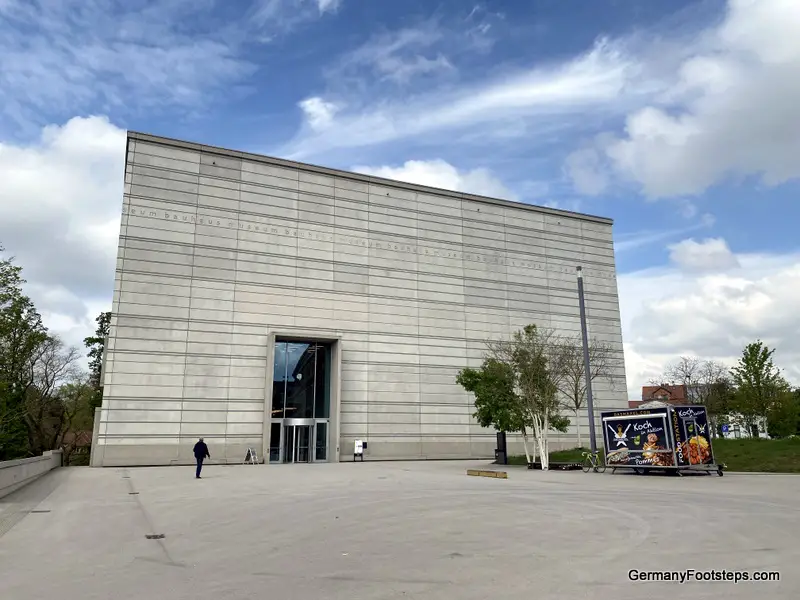
The Bauhaus Museum in Weimar is a pilgrimage site for admirers of modernist design and architecture. Weimar, as the birthplace of the Bauhaus movement, holds the roots of this influential school founded by Walter Gropius in 1919, which revolutionized the aesthetics of the 20th century.
This museum, a sleek testament to the Bauhaus ethos itself, presents a rich collection that delves into the school’s experimental teachings, its quest for functional design, and its profound impact on art, architecture, and design worldwide.
The museum’s exhibits, from furniture and household items to visual artworks, underscore the fusion of art and industry and the embrace of minimalist form-follows-function principles. This space does not just exhibit historical objects; it actively narrates the story of the Bauhaus, its visionaries, its successes, and the political turmoil that eventually led to its closure.
Linking the past with the present, it also examines the enduring legacy and contemporary influence of the Bauhaus principles.
There are also three examples of Bauhaus buildings in Weimar that are UNESCO-listed – the Former Art School, the Applied Art School and the Haus Am Horn. You can find more information on them and where to find them here.
12. Tour Schloss Tiefurt
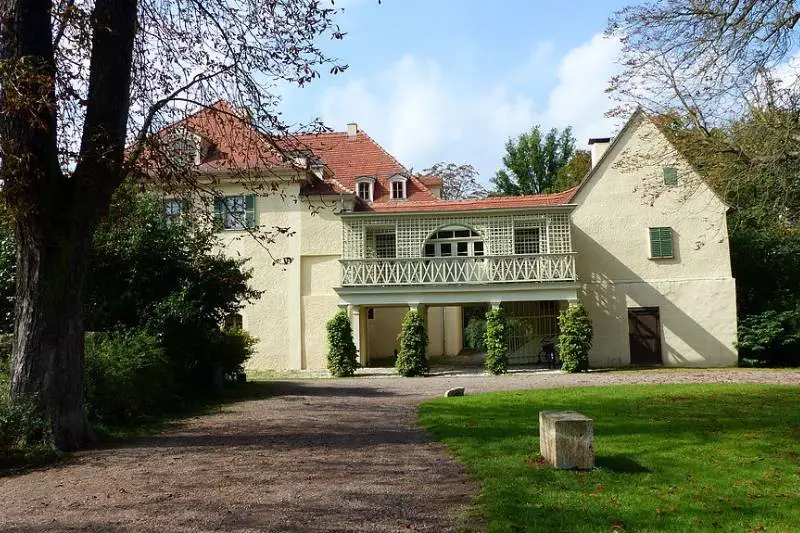
Schloss Tiefurt may be small compared to grander palaces, but its cultural significance is profound. This charming mansion turned summer residence is tucked away in the Tiefurt Park by the Ilm river, providing an intimate glimpse into ducal life of the 18th century.
It became a focal point for the arts and intellect under Duchess Anna Amalia, hosting literary salons where the Weimar Classicism movement flourished. Today, you can explore the idyllic English-style gardens and the elegantly furnished interior preserved to reflect its Enlightenment-era splendor.
The rooms are decorated with portraits, wall drawings, and memorabilia relevant to figures like Goethe and Schiller, who were regular guests, making the palace not just a residence but a live-in artwork of the period’s cultural landscape.
13. Visit the Buchenwald Memorial (Gedenkstätte Buchenwald)
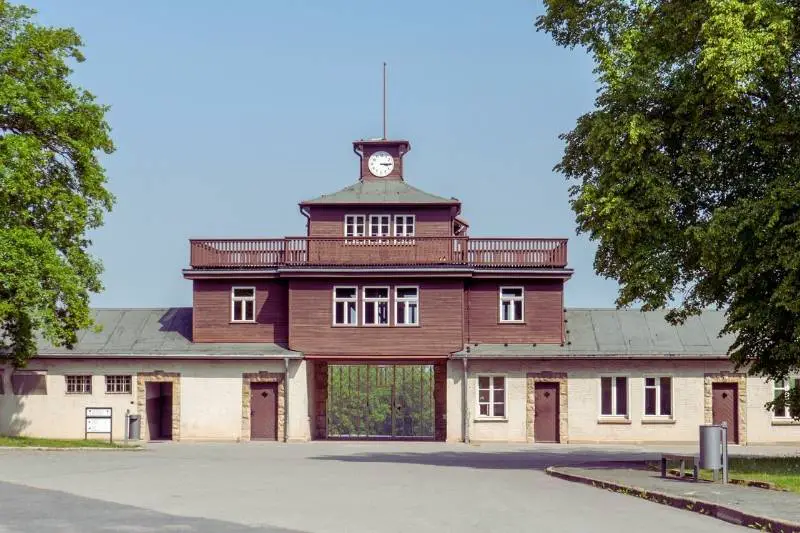
The Buchenwald Memorial represents a sobering chapter in human history, standing on the grounds of one of the largest concentration camps on German soil during World War II. This site honors the memory of those who suffered and perished under the Nazi regime.
The memorial’s exhibitions, historical documents, and preserved ruins of the camp, including watchtowers and barracks which are much as they were, confronts you with the grim realities of war and dictatorship. There’s also a 30-minute documentary film.
While the memories encapsulated here are harrowing, the visit is essential for its historical lessons on the value of human rights and the vigilance needed to protect them.
The Buchenwald Memorial offers guided tours, allowing for deeper insights into daily life in the camp and the broader context of the Holocaust, resistance efforts, and post-war justice. A visit here is incredibly moving and confronting and is not recommend for children under 12.
14. Experience Haus Hohe Pappeln
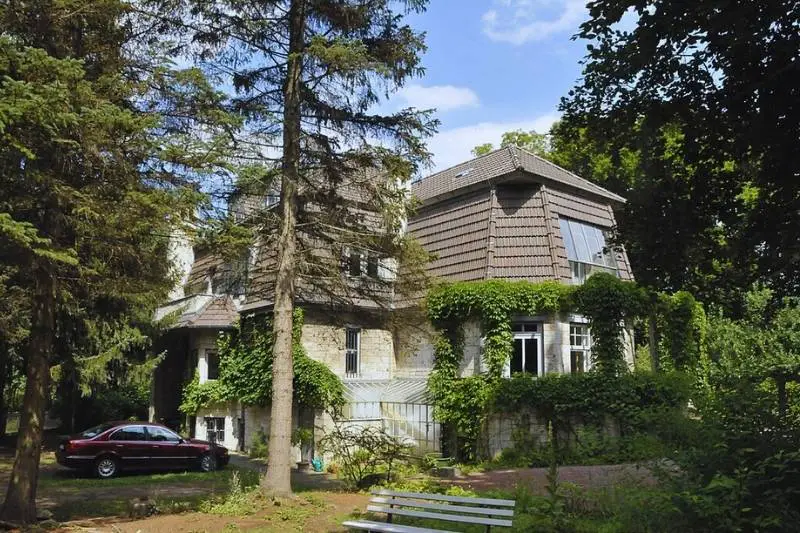
Haus Hohe Pappeln encapsulates the unique personal style of its original owner, Henry van de Velde, one of the pioneers of Art Nouveau architecture. Van de Velde lived in this unusual villa for nine years, designing every aspect of the house and garden to his aesthetic principles and personal demands.
Upon entering, you are treated to an authentic experience of an artist’s home from the beginning of the 20th century. The villa’s interior, with original furniture and decor, showcases the harmony of form and function that was revolutionary at the time, as well as van de Velde’s belief in the unity of art and life.
Each room is a statement of his artistic philosophy, and the home’s unity with nature speaks to van de Velde’s vision of an environment conducive to creativity and well-being. Visiting Haus Hohe Pappeln is not only a discovery of Art Nouveau but also an intimate encounter with the genius of an artist who left a significant mark on European design.
15. Visit Schloss Belvedere
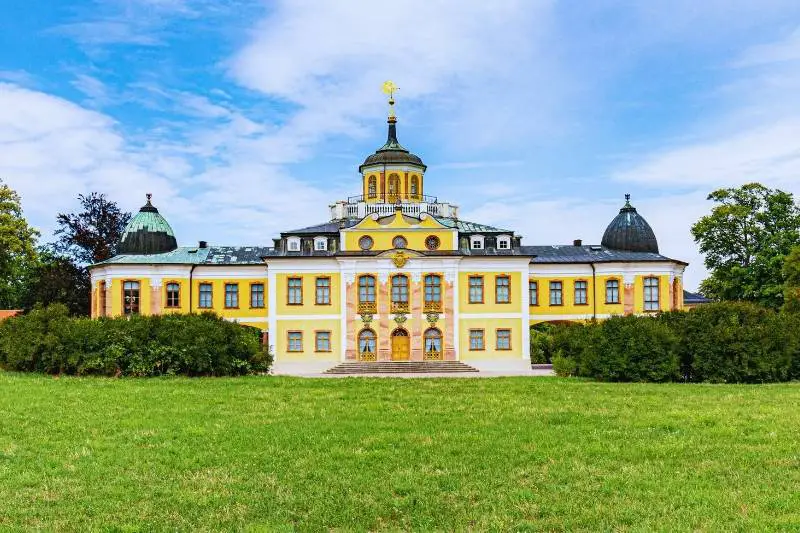
UNESCO-listed Schloss Belvedere concludes the cultural itinerary of Weimar with a flourish of baroque elegance. Built as a summer residence for Duke Ernst August of Saxe-Weimar, this ornate palace with its extensive orangery and park was the embodiment of courtly pleasure and luxury.
The architecture and decorations of the palace are a tribute to the baroque style, while its collection of ducal carriages and sleds are singularly impressive. The meticulously maintained park surrounding the Schloss is dotted with various sculptures, a labyrinth, and an array of botanical attractions that were once used for ducal entertainment and are now a fascinating exploration for the public.
A visit to Schloss Belvedere, now transformed into an art and cultural museum, offers insight into the opulence and aesthetics of the time and serves as a grand finale to the rich tapestry of historical experiences found in Weimar.
How To Get To Weimar
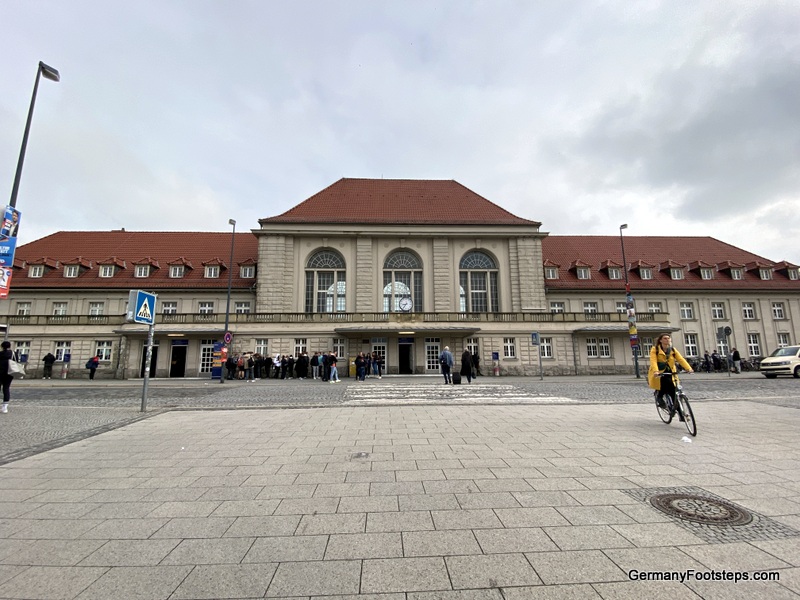
Venturing to the cultural gem of Weimar from elsewhere in Germany is generally quite straightforward.
If you’re starting from Berlin, the trusty Deutsche Bahn trains are your best companions. Board a direct train and sit back; within two to three hours, the verdant Thuringian countryside will welcome you to Weimar. The city’s quaint charm is a mere train ride away irrespective of your location.
Should you find yourself in Munich, a longer train journey of approximately 3 hours awaits. InterCity-Express is fast and frequent, a testament to German efficiency. Perhaps you’re closer, say in Leipzig or Halle. The short regional train rides from these cities offer a swift solution, whisking you to your destination in less than an hour. I visited from Erfurt which is less than 15 minutes away.
Click here to check out Deutsche Bahn schedules and prices.
Driving to Weimar unveils another aspect of Germany’s infrastructure. Autobahns connect seamlessly, threading major cities to this historical haven.
Click here to check out car hire options and prices.
And if you take the eco-friendlier route, buses are available to bridge the distance. They are a wallet-friendly option, albeit with longer travel times. Companies like FlixBus operate with free Wi-Fi and comfy seats, ensuring your journey is as pleasant as the destination itself.
Final Words
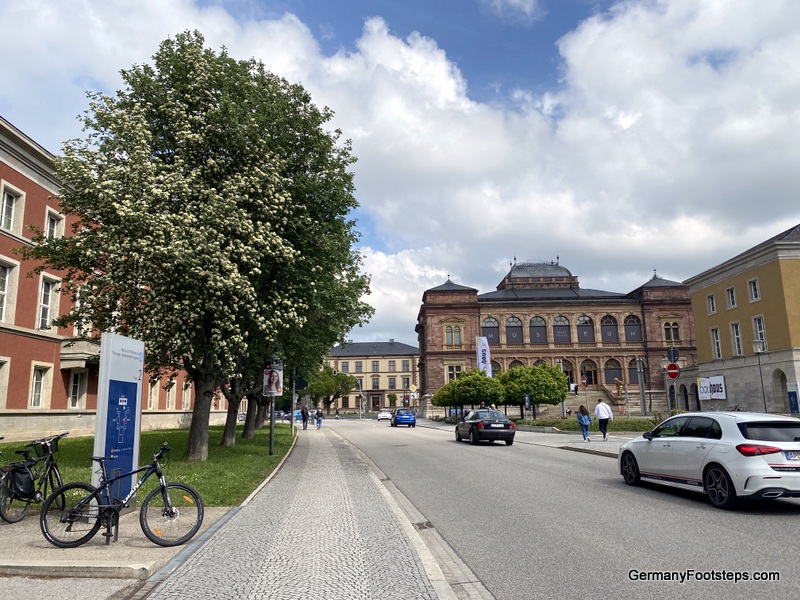
Weimar is a treasure trove of cultural heritage and intellectual history, with each corner echoing the footsteps of Germany’s great minds. From the sprawling parks to the intimate cafés, the city invites you to not only walk through its picturesque streets but also to immerse themselves in a deep, thought-provoking dialogue with the past.
Whether you find yourself reflecting in the serene environment of the Duchess Anna Amalia Library or exploring the vibrant colors of the Bauhaus Museum’s masterpieces, Weimar is a city that promises an enriching experience for every traveler.
Its harmonious blend of the arts, history, politics, and nature makes a trip to this vibrant city an unmissable chapter in the travelogue of anyone who appreciates the profound impact of German culture on the wider world.
Read our itinerary for Central Germany here or our guide to nearby Erfurt here, Eisenach here and Mühlhausen here. Find more guides to Central Germany here.

